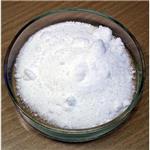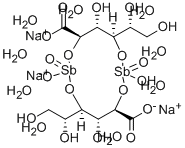Sodium Stibogluconate
- CAS No.
- 16037-91-5
- Chemical Name:
- Sodium Stibogluconate
- Synonyms
- SSG;NASB;NASBV;solustin;stibatin;stibinol;pentostam;myostibin;stibanate;stibanose
- CBNumber:
- CB0328463
- Molecular Formula:
- C12H37Na3O27Sb2
- Molecular Weight:
- 925.9
- MDL Number:
- MFCD01746582
- MOL File:
- 16037-91-5.mol
- MSDS File:
- SDS
| Melting point | >250°C (dec,) |
|---|---|
| storage temp. | 2-8°C |
| solubility | H2O: 1 mg/mL at ~75 °C |
| form | solid |
| color | pale yellow |
| Stability | Hygroscopic |
| InChIKey | VJCZMGLJTJZFEN-ZYPIZMQFSA-K |
| CAS DataBase Reference | 16037-91-5 |
| NCI Dictionary of Cancer Terms | sodium stibogluconate; SSG |
| FDA UNII | APJ6285Y89 |
| NCI Drug Dictionary | sodium stibogluconate |
| ATC code | P01CB02 |
SAFETY
Risk and Safety Statements
| Symbol(GHS) |   GHS07,GHS09 |
|||||||||
|---|---|---|---|---|---|---|---|---|---|---|
| Signal word | Warning | |||||||||
| Hazard statements | H302+H332-H411 | |||||||||
| Precautionary statements | P261-P264-P270-P273-P301+P312-P304+P340+P312 | |||||||||
| Hazard Codes | Xn,N | |||||||||
| Risk Statements | 20/22-51/53 | |||||||||
| Safety Statements | 61 | |||||||||
| RIDADR | 3282 | |||||||||
| WGK Germany | 3 | |||||||||
| RTECS | CC7930000 | |||||||||
| HazardClass | 6.1(b) | |||||||||
| PackingGroup | III | |||||||||
| Toxicity | LD50 ipr-mus: 33 mg/kg CLDND* 11,155,49 | |||||||||
| NFPA 704 |
|
Sodium Stibogluconate price More Price(13)
| Manufacturer | Product number | Product description | CAS number | Packaging | Price | Updated | Buy |
|---|---|---|---|---|---|---|---|
| Sigma-Aldrich | 567565 | Sodium Stibogluconate - CAS 16037-91-5 - Calbiochem | 16037-91-5 | 1g | $144 | 2024-03-01 | Buy |
| Cayman Chemical | 16038 | Sodium Stibogluconate ≥95% | 16037-91-5 | 250mg | $49 | 2024-03-01 | Buy |
| Cayman Chemical | 16038 | Sodium Stibogluconate ≥95% | 16037-91-5 | 1g | $153 | 2024-03-01 | Buy |
| Cayman Chemical | 16038 | Sodium Stibogluconate ≥95% | 16037-91-5 | 500mg | $87 | 2024-03-01 | Buy |
| TRC | S670960 | Sodium Stibogluconate | 16037-91-5 | 5g | $325 | 2021-12-16 | Buy |
Sodium Stibogluconate Chemical Properties,Uses,Production
Description
Sodium stibogluconate is a pentavalent antimony derivative that is highly active against Leishmania amastigotes in macrophages. Sodium stibogluconate has diverse effects on both this intracellular parasite and its host cell.
Uses
Sodium stibogluconate is a pentavalent antimony derivative that is highly active against Leishmania amastigotes in macrophages. Sodium stibogluconate has diverse effects on both this intracellular parasite and its host cell.
Uses
Sodium Stibogluconate is an intermediate used to prepare Dihydropyrido[2,3-d]pyrimidines as a new class of antileishmanial agents.
Antimicrobial activity
It has low activity against the extracellular promastigote stage of Leishmania spp. in vitro, but is active against amastigotes in macrophages. The trivalent form is considered to be the toxophore, with metabolism of SbV to toxic SbIII in the host cell macrophage and the parasite; the level of metabolism is higher in amastigotes than promastigotes. Variation in the sensitivity of different Leishmania species may contribute to differences in clinical response. It is more active against visceral than cutaneous leishmaniasis in animal models. Sodium stibogluconate cures CNS infections with T. brucei in rodents.
Acquired resistance
Unresponsiveness and relapse of L. donovani infections in
Bihar State, India (over 60% of cases), is due to increasing
acquired resistance. In laboratory-generated and clinical
isolates,
resistant Leishmania promastigotes show increased
levels of intracellular thiols, for example trypanothione, to
which SbIII is conjugated and extruded by efflux pumps.
Lack of response is also reported in patients with mucosal
leishmaniasis caused by L. braziliensis. Relapse is common
in patients with visceral leishmaniasis who are immunosuppressed,
for example by HIV infection, but this is due to
pathogen interaction and the immune dependence of drug
activity and not acquired resistance. High mortality has been
reported in treatment of these co-infection cases.
Pharmaceutical Applications
A pentavalent antimonial of uncertain chemical composition; probably a complex mixture of polymeric forms. There is batchto- batch variation and solutions may contain 32–34% pentavalent antimony (SbV). The structural formula is conjectural as studies have identified a mixture of non-complexed SbV and large polymeric gluconate complexes. Chemical composition also depends on concentration and time. It is freely soluble in water.
Pharmacokinetics
Peak concentrations of about 12–15 mg antimony/L are achieved in serum 1 h after a dose of 10 mg/kg. There is a slow accumulation in the central compartment, and tissue concentrations reach a maximum after several days. In contrast to trivalent derivatives, pentavalent antimonials are not accumulated by erythrocytes, but there is evidence of protein binding. Antimony is detected in the skin for at least 5 days after treatment. Some of the dose of SbV is converted to SbIII, possibly by the liver or by macrophages. It is rapidly excreted into urine with a half-life of about 2 h; 60–80% of the dose appears in the urine within 6 h of parenteral administration. In a study on structurally related meglumine antimonate the pharmacokinetics of SbV and SbIII were similar as measured by serum and urine levels.
Clinical Use
Visceral, cutaneous and mucocutaneous leishmaniasis
The combination with paromomycin has been used in unresponsive
cases and in relapses of visceral and cutaneous
leishmaniasis.
Clinical Use
Sodium antimony gluconate (Pentostam) is a pentavalent antimonialcompound intended primarily for the treatment ofvarious forms of leishmaniasis. It is available from the CDCas the disodium salt, which is chemically stable and freelysoluble in water. The 10% aqueous solution used for eitherintramuscular or intravenous injection has a pH of approximately5.5. Like all antimonial drugs, this drug has a lowtherapeutic index, and patients undergoing therapy with itshould be monitored carefully for signs of heavy metal poisoning.Other organic antimonial compounds are used primarilyfor the treatment of schistosomiasis and other flukes.The antileishmanial action of sodium stibogluconate requiresits reduction to the trivalent form, which is believedto inhibit phosphofructokinase in the parasite.
Side effects
The toxic effects are limited by the rapid excretion, but cumulative toxicity increases in proportion to dose. Myalgia, arthralgia, anorexia and electrocardiographic changes have been reported with high-dose regimens. In particular, development of ventricular tachyarrhythmias associated with prolongation of the QT interval has been recorded. Hepatocellular damage, hepatic and renal functional impairment and pancreatitis have also been reported. The changes are reversible on discontinuation of treatment.
Safety Profile
Poison by intraperitoneal route. When heated to decomposition it emits toxic fumes of Sb.
Veterinary Drugs and Treatments
Sodium stibogluconate is used for the treatment of leishmaniasis in dogs.
Drug interactions
otentially hazardous interactions with other drugs
P
Antifungals: possible increased risk of arrhythmias
with amphotericin - give 14 days apart.
Metabolism
No data on possible metabolic pathways.
Elimination occurs in two phases; a rapid initial phase, in
which the majority of a dose is excreted via the kidneys
within 12 hours, and a slower phase, possibly reflecting
reduction to trivalent antimony.
Sodium Stibogluconate Preparation Products And Raw materials
Raw materials
Preparation Products
| Supplier | Tel | Country | ProdList | Advantage | |
|---|---|---|---|---|---|
| shandong perfect biotechnology co.ltd | +86-53169958659; +8618596095638 | sales@sdperfect.com | China | 294 | 58 |
| Henan Tianfu Chemical Co.,Ltd. | +86-0371-55170693 +86-19937530512 | info@tianfuchem.com | China | 21695 | 55 |
| Hubei Jusheng Technology Co.,Ltd. | 18871490254 | linda@hubeijusheng.com | CHINA | 28180 | 58 |
| Hubei xin bonus chemical co. LTD | 86-13657291602 | linda@hubeijusheng.com | CHINA | 22968 | 58 |
| BOC Sciences | +1-631-485-4226 | inquiry@bocsci.com | United States | 19553 | 58 |
| CONIER CHEM AND PHARMA LIMITED | +8618523575427 | sales@conier.com | China | 47465 | 58 |
| Shaanxi Dideu Medichem Co. Ltd | +86-29-87569266 15319487004 | 1015@dideu.com | China | 2263 | 58 |
| TargetMol Chemicals Inc. | +1-781-999-5354 +1-00000000000 | marketing@targetmol.com | United States | 19892 | 58 |
| Longyan Tianhua Biological Technology Co., Ltd | 0086 18039857276 18039857276 | CHINA | 2783 | 58 | |
| Hefei TNJ Chemical Industry Co.,Ltd. | 0551-65418671 | sales@tnjchem.com | China | 34572 | 58 |
View Lastest Price from Sodium Stibogluconate manufacturers
| Image | Update time | Product | Price | Min. Order | Purity | Supply Ability | Manufacturer | |
|---|---|---|---|---|---|---|---|---|
 |
2024-03-12 | Sodium Stibogluconate
16037-91-5
|
US $0.00 / KG | 1KG | 98% HPLC | 5000kgs | shandong perfect biotechnology co.ltd | |
 |
2021-06-19 | Sodium Stibogluconate USP/EP/BP
16037-91-5
|
US $1.10 / g | 1g | 99.9% | 100 Tons Min | Dideu Industries Group Limited | |
 |
2020-04-28 | Sodium Stibogluconate
16037-91-5
|
US $0.00-0.00 / Kg | 1KG | 99.0% | 500 tons | Shaanxi Dideu Medichem Co. Ltd |
-

- Sodium Stibogluconate
16037-91-5
- US $0.00 / KG
- 98% HPLC
- shandong perfect biotechnology co.ltd
-

- Sodium Stibogluconate USP/EP/BP
16037-91-5
- US $1.10 / g
- 99.9%
- Dideu Industries Group Limited
-

- Sodium Stibogluconate
16037-91-5
- US $0.00-0.00 / Kg
- 99.0%
- Shaanxi Dideu Medichem Co. Ltd





